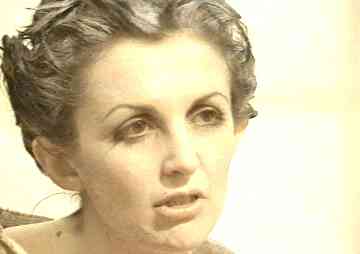
| A dreamhead, addicted to shadow, and Bek's sister on Space City. It was through her that Largo was able to track the Liberator when Blake left for Zonda. She died trying to deactivate Orac, on which Avon commented, "She was dying anyway". |  |
| One of the Death Squad troopers who boarded the Liberator with Klegg. Avon believed that Harmon was responsible for the deaths of two other troopers after seeing him leave the ship's strong room. The killings were in fact due to Tarrant, who shot Harmon when he attacked Avon. | 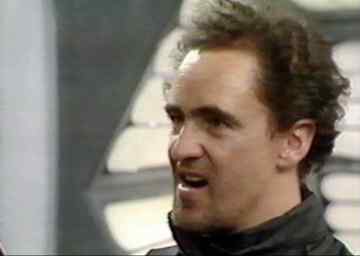 |
A harmonica was heard to be played by one of the prisoners from Kalkos aboard the T-16 transporter taking them to Sardos.
Hunda's second in command on Helotrix, given the rank of sergeant in the end credits. Hunda gave Hask command of the 4th column when he left to enter the city. Little more was said about Hask other than the fact that he was not a geologist.
| Doctor at the Central Clinic on Earth. He confirmed Alta Morag's suggestion that false memories could be implanted in a subject, and treated three children to make them believe they had been indecently assaulted by Blake. Although the term was not used, he was probably a criminotherapist. | 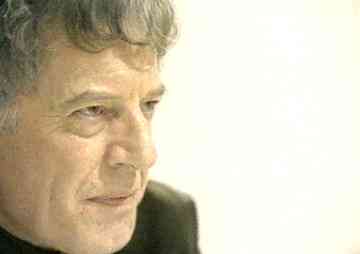 |
One of the frontier worlds listed by Durkim as experiencing a breakdown in climate control, along with Carthenis, Palmero, Sooni and Vilker.
In many religions, the place or state of eternal punishment of the wicked after death. Twenty-one characters made 62 references to hell in the series: Avon (17), Vila (12), Del Tarrant (9), Blake (4), Leylan, Deeta Tarrant, and Casgo (2 each); and Provine, Servalan, Raiker, Par, Thania, Gambrill, Tek, the Nova Queen's pilot, Dayna, Grenlee, Doran, Dorian, Plaxton, and Soolin (1 each), which can be divided into 5 categories. While the first two indicate a link with the origin of the word, the other three, comprising the majority of the references, indicate a complete break with the origin, probably due to the passage of time and the Federation's anti-religious policy.
1. The use of the word in the belief that one is actually in hell: Vila, when he recovered consciousness in Dawn of the Gods, saw numerous images of Avon and muttered, 'I'm in hell - and it's full of Avons!' From what was seen of Vila in the series, this reference did not presumably indicate any religious belief on his part, including a belief in the existance of hell, only a belief that a place full of Avons was his vision of hell, if it existed.
2. The use of the word as a wish of evil:
3. The use of the word as an expression of anger or astonishment:
4. The use of the word as a phrase telling someone to make a quick retreat:
5. The use of the word as a description of something tremendous, serious, great, or important:
See RELIGION.
A remnant of the pre-war technology on Xenon. Avon used one, protected by a glove, to defeat Gunn-Sar in single combat, and described it as "ordinary" and "domestic", although this might have been irony on his part.
One of the oldest Earth colonies, colonised when the Stock Equalisation Act was still in force. The Federation spent years subduing the population during their first expansion. Avon added that the Helots were among the first to gain independence from "the Empire": this might refer to the Federation in the aftermath of the Intergalactic War, or possibly some pre-Federation power bloc. Hunda mentioned an old monorail tunnel being sealed off "a hundred years ago", showing that the planet had been colonised for over a century (though since Chenga had been colonised for two hundred years in Powerplay, Helotrix's pioneer settlements were almost certainly older).
Helotrix was served by Magnetrix Terminal 4006, situated in an unnamed city on the planet. What little was seen of the city indicated buildings of a pyramidal shape. It can be inferred that Helotrix was in Sector 4, and was the target of the Pacification Programme after Luba and Porphyr Major.
Helotrix was visited by Tarrant, Dayna, and Servalan (as Commissioner Sleer). Named Helots were Practor (President-elect, relieving the military as ruler of the planet for the Federation), Star Major Hunda, Hask, Avandir and Igin. Named places were Leedenbrank and the White Mountains.
The General had previously led a squadron of Helots and regarded them as good fighters, especially in hand-to-hand combat. Of the rebels on the planet at the time of Scorpio's visit, only Hunda's 4th column was still fighting. Column 2 had been virtually wiped out, with 1 and 3 withdrawing to the White Mountains.
One of the prisoners held on the unnamed planet in this episode, detained in cell S8. Others noted were Distar, Kalor and Pelar.
Described by Avon in Dawn of the Gods as "the strongest known metal in the universe", the outer skin of the Liberator was made from it. It was stated to be an alloy, although it could apparently be found occurring naturally in some asteroids. Zen identified the landing module from Kairos, fitted with an analogue of Sopron, as having a herculanium hull.
In Power Vila identified the door to Scorpio's hangar as being made of herculanium, and added that it could not be cut, burnt or blasted.
|
A border system, represented by Lod at the meeting of warlords called by
Avon. Avon noted that Herriol, along with Serrus and Sentha, was threatened
by the Federation's pacification Programme.
| 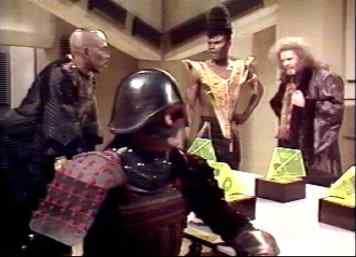 Lod is on the left |
Mentioned by Blake as a means of coping with the stresses of lengthy confinement in early infraluminal space flights.
'High Admiral of the Galactic Fleets' was one of Servalan's presidential titles, mentioned by Tarrant in 'Rumours of Death'. This title seems quite similar to that of 'Lord High Admiral of the United Kingdom', a title held by the monarch of that Earth state since 1 April 1964 AD.
The office was established in the fourteenth century, when the English fleet first came under a single admiral's command. The title became fixed as 'Lord High Admiral' by the sixteenth century; previously the titles 'High Admiral' or 'Lord Admiral' were used interchangeably. From 1628 to 1964, except for certain periods, the office was in commission, the Lords Commissioners of the Admiralty being vested with all its jurisdictions and powers.
See also Rank.
Governing body of unspecified size, at the top of the Federation's hierarchy. Among the Presidential titles listed by Tarrant in Rumours of Death, one was "Ruler of the High Council". No details were given as to the composition of the High Council, or how its members were chosen. Other references include:
| Part of Control's defences, surrounding the bunker entrance for a radius of "fifty yards, maybe more", at least in Vila's estimate. Avon stated that the rays could burn an individual up in seconds, and noted that it was completely self-repairing in eight seconds. An inbuilt sensormesh was weight and disturbance sensitive. The grid also had the apparent ability to fix people to the spot, preventing their escape. Responsible for the deaths of Arle and Berg, it very nearly claimed Avon as well. It was deactivated to allow Travis and two mutoids to enter the bunker, and Servalan, Jenna and Veron later crossed it unharmed. If it remained deactivated after Blake's escape, then Veron may have been able to get away unharmed, otherwise she would have been trapped in the bunker or killed. | 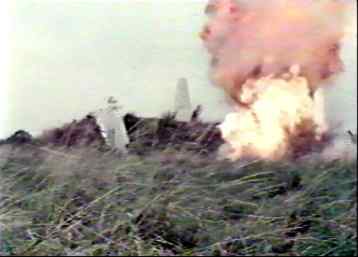 Arle & Berg being blown up. |
Cited by Vila as a good reason for going back to Earth: "The Himalayas are quite tall at this time of year". The only major geographical feature on Earth to be mentioned by name.
| One of the two factions on Chenga, disagreeing from the Primitives in believing in the use of high technology to better their lives. The Hitechs used Primitives and others as a source of organs for prolonging their own lives, and employed bounty hunters to catch Primitives for such purposes. Vila was brought in by Zee and Barr, whilst Cally was one of 64 people (including Servalan) brought in on a ship picking up survivors from the Intergalactic War. Servalan used her position to escape the Hitechs, but Cally and Vila had to be rescued at the last minute. | 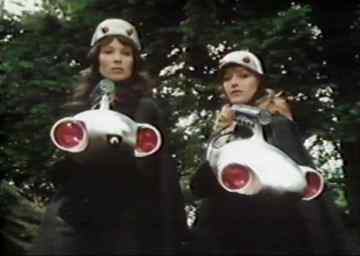 Zee and Barr |
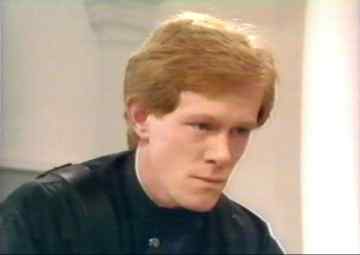 | A rebel on Earth, working with Sula to depose Servalan and establish a People's Council. Sula persuaded him not to have Servalan killed, and he backed her up in persuading the other rebels in this matter. He was killed by Servalan when he followed Sula to the cellar, distracting Servalan long enough to allow Avon to teleport safely back to the Liberator. |
Egrorian mentioned Hofel as the scientist who over a hundred years previously had predicted many of the properties of neutron star material. Since these properties have to some extent already been predicted, it would seem likely that Hofel's predictions were pertinent to currently unconsidered applications.
Hofel's radiation was released from neutrons subjected to an intense magnetic field. Severe temporal displacement resulted from this - Pinder had aged fifty years in as many seconds after being exposed to Hofel's radiation for a mere millionth of a second. Pinder later released a fatal dose of Hofel's radiation to kill himself and Egrorian.
Since there are references elsewhere in the series to "neutron" drives, it could well be that the process which generated Hofel's radiation was a fundamental principle of time distort drive technology. Protective shielding could be applied against the radiation and its effects, somewhat necessary if the process was used to power crewed spacecraft.
| The place where prisoners were held as the prison ship took off. Described by Vila as "cold as a corpse's armpit". The doorway to the surface was opened by Artix by remote control once the London had taken off. | 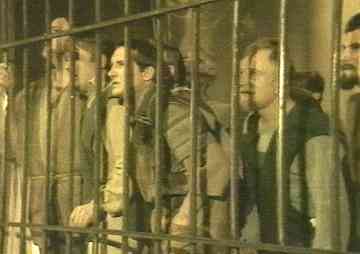 |
A command of the Federation's Justice Department, used to halt the execution of sentence on a sentenced prisoner. It could be used if a reasonable doubt was raised about the conduct of that prisoner's case, sufficient to amount to a possible miscarriage of justice. After it was made under those circumstances, an inquiry would usually be ordered to ascertain the truth.
In The Way Back, Varon implicitly stated that this order could be obtained fairly quickly when he told Blake that the latter would be taken from the transit cell back to the city detention area within a couple of hours.
From Ven Glynd's agreement to order an inquiry into Blake's case, it is possible that the Arbiter General's consent was necessary for the issuing of such an order.
See also ARBITER GENERAL, JUSTICE DEPARTMENT.
 The Collar of the Order of the Holy Spirit |
A French order of knighthood, whose badge was part of the gold sash worn
around the waist of the Caliph of Crandor, the lieutenant of the Thaarn. The
order was instituted on 31 December 1578 by King Henry III of France, a monarch
who had a particular devotion to the Holy Spirit, as his birth and accession
to the Polish (1573) and French (1574) thrones all occurred on the day of
Pentecost (also called Whitsunday). It was on that day, the fiftieth after
Easter, that the Holy Spirit descended on the first Christians (Acts 2).
|
|
The objects of the Order were to defend the Catholic faith and to uphold the
Catholic nobility. It had one class, and was limited to 100 members, all of
whom had to be noble and to profess the Catholic faith. The Badge of the
Order is a gold, ball-tipped Maltese Cross, enamelled in white and green,
with a gold fleur-de-lys between each arm. In the centre is a white
enamelled dove flying with the head downwards - the traditional repesentation
of the Holy Spirit. The centre of the reverse is occupied by St. Michael
slaying a dragon. The badge was suspended from a sky blue riband worn over
the right shoulder. A silver star, embroidered with the same cross and dove,
complemented the Badge.
|  The Collar design. |
 The Badge in detail |
The Order was abolished during the French Revolution, but King Louis XVIII
awarded it while in exile, and re-established it in 1814, after the
restoration of the Bourbons. It was again abolished in 1830 by the July
Monarchy of King Louis-Philippe; but awards of it have since been made by
pretenders to the French throne. The reason for the latter actions is that,
at present, the Order is regarded as a dynastic order, one that belongs to a
sovereign Royal House, regardless of the fact that it is not regnant. The Head
of the French Royal House and his legitimate successors continue to enjoy the
right to bestow it, as it is regarded as an order to reward personal services
to the Royal House or its Head.
|
A term used for holy writings, in particular the Bible or Holy Scriptures. In Rumours of Death, when Section Leader Forres asked Major Grenlee if he should seal the perimeter, due to a surveilance malfunction, the latter refused. When Forres pointed out that this was standard procedure, Grenlee responded, 'I don't give a damn if it's Holy Writ'.
This reference, while an implicit one to Christianity, was presumably unwittingly used by Grenlee as a general one to an authoritative text; because the reference had become detached from its Christian origin, both by time and by the Federation's anti-religious policy.
See also CHRISTIANITY.
One of the names suggested by Kerril for the planet she and Vila were taken to from Keezarn. Vila preferred Vilaworld as a name, but offered to let it be called Homeworld when she stormed off back to the ship.
| A variety of different homing devices were seen during the course of the series. The homing beacon used by the rebels in Project Avalon was a relatively large structure, but the devices used by Kasabi in Pressure Point, carried by Blake in Trial and Sara's homing beam transmitter in Mission to Destiny were pocket-sized: the latter had an implicitly considerable range, since its signal was intended for an unnamed party arriving in a ship of their own. | 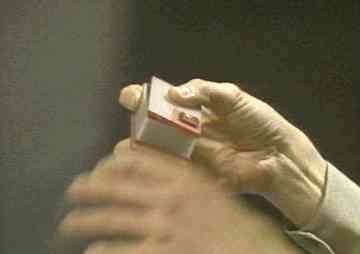 Sara's homing beam transmitter in Mission to Destiny Sara's homing beam transmitter in Mission to Destiny |
Few details of homing beacon transmissions were given, although Kasabi's in Pressure Point was to be placed at grid reference 331-1101, emitting a 3-long/2-short pulse sequence.
Tribe descended from the Council of Survivors after the war that destroyed Xenon's civilisation. The Hommiks appeared to be almost entirely male, and relied on capturing the Seska to supply them with wives and hence sons: daughters were left on the hillsides, and some were found by the Seska. Those near Dorian's base were under the rule of Gunn-Sar. There may or may not have been others elsewhere on the planet. After Gunn-Sar's death, Nina vowed to lead the Hommiks away to a new home.
Pella told Avon that the Hommiks reverted to primitive tribalism "centuries ago". Cato referred to a council that could apparently challenge Gunn-Sar's authority.
|
Federation code-name for the planet Silmareno, "on the edge of the spiral
rim" and the only habitable planet in Zone Nine. It was visited annually by
a Federation freighter to take back monopasium-239 mined by the natives.
Nominally ruled by Ro, a native trained at the Central Educational Complex,
the Federation's Colonial Service kept its own representatives and a small
garrison present at all times. The planet was protected by a magnetic
barrier, and only Liberator's force wall prevented the ship from being
atomised.
| 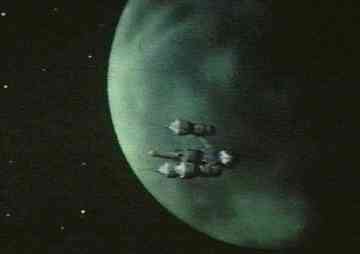 |
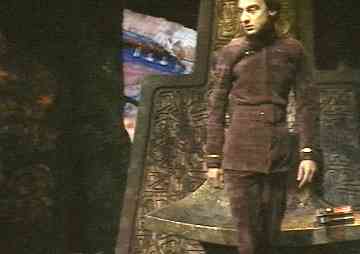 Ro |
Whilst under torture, Blake openly called Ro a human being, a statement which
Ro did not gainsay, so it might be inferred that the inhabitants of Horizon
were descended from Earth colonists. Their culture, although technologically
primitive, was ornate and intricate, reminiscent of early South American
civilisation. Once the Federation personnel had been eliminated, Ro
installed himself as the true ruler. The name Horizon was, however,
retained.
|
The name by which Zil referred to the living planet on which it and its species lived. Most of the Host's southern hemisphere was ocean, and Zen reported gravitational anomalies on the surface.
The planet's "oceans" had a composition analogous to saliva, and could swamp the landmasses in a matter of hours to cleanse the surface of parasites such as Zil. The planet's "crust" was very thin in at least some places, and the underlying substance was a source of food for Zil and its kind. Areas of the surface could open up to swallow unwary parasites. Vegetation, or something extremely like vegetation, was abundant on the land, and surface water was also present. The Host represents a fascinating (if improbable) organism in its own right, raising many awkward questions with regard to reproduction, movement, nutrition and especially evolution.
|
The First Citizen of Obsidian, and a former associate of Hal Mellanby at the
Federation's Central Science Complex. He had renounced all forms of
violence, as had all the people of Obsidian, and believed that "Homo
sapiens has reached a point where further technological development is
pointless". His son, Bershar, was less committed to such lofty principles
and secretly worked in league with Servalan. Hower administered a lethal
overdose of anesthetic and killed him, later dying himself when he activated
the nuclear device buried in the volcano, destroying the planet.
| 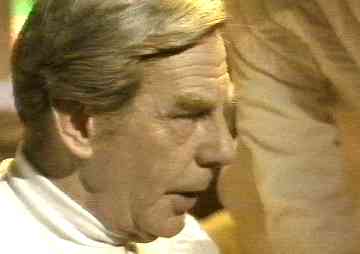 |
One of the detector systems on Liberator, mentioned several times. They detected scanning beams by enemy ships in Project Avalon, and the gravitational field of UP-The Web. They also reported the presence of the fluid particles attached to the outer hull in Terminal before the fluid's enzyme activity impaired their functioning. These references suggest that the hull sensors were largely if not totally a "passive" detector system.
A Helot rebel, with the rank of Star Major apparently a self-styled title. A former lecturer or researcher in geology, first assistant to fellow rebel Igin at Leedenbrank, he was in command of the Helot resistance's 4th column. Hunda blamed himself for Igin's death, and later swam into the city to assess the possibility of demolishing the magnetrix terminal. He believed that Leitz was a traitor to the Federation, but was told the truth by Dayna and Tarrant, who joined him on a successful attack on the city.
Shortly after leaving Earth, Commander Leylan gave an order to "cut in the hyperdrive, Time Distort five". Jenna noted that hyperdrive running was expensive, and that the London's hyperdrive was an early mark in need of "restressing".
See also PHOTONIC DRIVE, SPEED, TIME DISTORT, INTERGALACTIC DRIVE.
Mentioned by Ro as a new kind of ship, presumably with a new kind of drive, needing monopasium 239 to travel to other galaxies within a reasonable period of flight time.
According to Avon, the means by which all Federation communications were transmitted. The messages were converted to zeta-3 particles before scrambling. A sub-beam communicator was found on Cephlon and used to contact Liberator: this presumably used the same principle, and likewise the sub-space communicator taken by Coser to UP-Weapon. The A-line pulse codes featured in Killer may have been an alternative means of transmitting information, or new and improved communications technology.